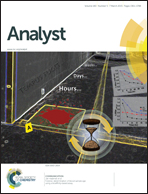Rapidly prototyped multi-scale electrodes to minimize the voltage requirements for bacterial cell lysis
Abstract
Lab-on-a-chip systems used for nucleic acid based detection of bacteria rely on bacterial lysis for the release of cellular material. Although electrical lysis devices can be miniaturized for on-chip integration and reagent-free lysis, they often suffer from high voltage requirements, and rely on the use of off-chip voltage supplies. To overcome this barrier, we developed a rapid prototyping method for creating multi-scale electrodes that are structurally tuned for lowering the voltage needed for electrical bacterial lysis. These three-dimensional multi-scale electrodes – with micron scale reaction areas and nanoscale features – are fabricated using benchtop methods including craft cutting, polymer-induced wrinkling, and electrodeposition, which enable a lysis device to be designed, fabricated, and optimized in a matter of hours. These tunable electrodes show superior behaviour compared to lithographically-prepared electrodes in terms of lysis efficiency and voltage requirement. Successful extraction of nucleic acids from bacterial samples processed by these electrodes demonstrates the potential for these rapidly prototyped devices to be integrated within practical lab-on-a-chip systems.


 Please wait while we load your content...
Please wait while we load your content...